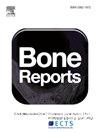VEGF-A、-C、-D、VEGFR1、-2、-3、PDGF-BB和FGF-2共同诱导髋关节植入物骨愈合过程中的血管和淋巴血管生成
IF 2.6
Q3 ENDOCRINOLOGY & METABOLISM
引用次数: 0
摘要
血管生成生长因子是骨创伤后骨修复和再生的关键部分。在本研究中,我们监测了髋关节骨整合过程中血管生成因子和受体的时空反应。材料和方法24例因单侧骨关节炎(OA)接受原发性全髋关节置换术(THA)的患者在18年(Y)期间通过反复测量血浆生物标志物以及临床和放射学变量进行监测,后两者显示研究中的所有植入物在整个随访期间锚定良好。81名健康供体分为三个性别和年龄匹配的亚组,20名等待THA的OA患者作为对照。分析血浆中血管内皮生长因子(VEGF)-A、VEGF- c、VEGF- d、血管内皮生长因子受体1 (VEGFR1)或sFlt-1、VEGFR2 (KDR/sFlk-1)、VEGFR3 (sFlt-4)、血小板衍生生长因子- bb (PDGF-BB)、成纤维细胞生长因子-2 (FGF-2)和胎盘生长因子(PIGF)的含量。生物标志物的分析是通过高灵敏度和宽动态范围的电化学发光技术完成的,允许检测低水平和微小变化的生物标志物水平。在软骨内骨修复的四个阶段的背景下,随访期间THA患者生物标志物的时空变化。结果术前OA患者的vegf - a、VEGFR1、PDGF-BB和FGF-2水平显著高于健康受试者,而VEGF-C水平显著低于健康受试者,但在植入手术后不久均恢复正常。VEGF-A、VEGF-C、VEGF-D、VEGFR2、VEGFR3、FGF-2和PDGF-BB在植入后1-2 Y急剧升高,在植入后5-7 Y达到峰值,术后13-15Y恢复到控制水平,但VEGF-D在植入后7Y恢复到控制水平。VEGFR1在tha后6周降至健康受试者的水平,并在整个研究过程中保持该水平。在随访期间,PIGF与健康受试者没有任何差异。结论术前OA相对健康患者VEGF-A、VEGFR1、PDGF-BB和FGF-2水平升高,VEGF-C水平降低,支持骨性关节炎软骨保护或疾病诱导作用。除VEGFR1和PIGF外,本研究中所有促血管生成因子在髋关节置换术后5 Y的一致增加,有力地支持了这是骨修复的阶段,此时血液和淋巴管侵入无血管钙化的肥厚软骨并触发其重塑成骨。本文章由计算机程序翻译,如有差异,请以英文原文为准。
VEGF-A, -C, -D, VEGFR1, -2, -3, PDGF-BB and FGF-2 join forces to induce vascular and lymphatic angiogenesis during bone healing of hip implants
Introduction
Angiogenic growth factors are a critical part of bone repair and regeneration in the aftermath of bone trauma. In the current study we monitored the spatiotemporal responses of angiogenic factors and receptors during the process of osseointegration of hip implants.
Materials and methods
Twenty-four patients having undergone primary total hip arthroplasty (THA) due to one-sided osteoarthritis (OA) were monitored during a period of 18 years (Y) by repeated measurements of plasma biomarkers as well as clinical and radiographic variables, the latter two showing all implants of the study to be well anchored throughout the follow-up. Eighty-one healthy donors divided into three gender- and age-matched subgroups and twenty OA patients awaiting THA, served as controls. Plasma was analyzed for vascular endothelial growth factor (VEGF)-A, VEGF-C, VEGF-D, vascular endothelial growth factor receptor 1 (VEGFR1) or sFlt-1, VEGFR2 (KDR/sFlk-1), VEGFR3 (sFlt-4), platelet derived growth factor–BB (PDGF-BB), fibroblast growth factor-2 (FGF-2) and placental growth factor (PIGF). Analysis of biomarkers was done by means of a high-sensitivity and wide dynamic range electrochemiluminescence technique allowing for detection of low levels and minor changes in biomarker levels. Spatiotemporal changes of biomarkers in THA patients during the follow-up were presented in the context of the four phases of endochondral bone repair.
Results
VEGF-A, VEGFR1, PDGF-BB and FGF-2 were significantly higher, whereas VEGF-C was significantly lower in presurgery OA patients versus healthy subjects but were all normalized shortly after implant surgery. VEGF-A, VEGF-C, VEGF-D, VEGFR2, VEGFR3, FGF-2 and PDGF-BB increased sharply 1–2 Y post-implant and reached a peak significantly above healthy control subjects at 5–7 Y after implant insertion before returning to control level 13-15Y post-surgery, except for VEGF-D that returned to control level at 7Y post-implant. VEGFR1 decreased to the level of healthy subjects at 6 W post-THA and remained there throughout the study. PIGF did not differ from healthy subjects at any point during the follow-up.
Conclusion
Increased levels of VEGF-A, VEGFR1, PDGF-BB and FGF-2 and reduced VEGF-C in presurgery OA relative healthy subjects support a cartilage protective or disease-inducing role in osteoarthritis. The concerted increase by all proangiogenic factors of the study, except VEGFR1 and PIGF, at 5 Y post-implant lend strong support to this being the phase of bone repair when blood and lymph vessels invade the avascular calcified hypertrophic cartilage and trigger its remodeling into bone in hip arthroplasty patients.
求助全文
通过发布文献求助,成功后即可免费获取论文全文。
去求助
来源期刊

Bone Reports
Medicine-Orthopedics and Sports Medicine
CiteScore
4.30
自引率
4.00%
发文量
444
审稿时长
57 days
期刊介绍:
Bone Reports is an interdisciplinary forum for the rapid publication of Original Research Articles and Case Reports across basic, translational and clinical aspects of bone and mineral metabolism. The journal publishes papers that are scientifically sound, with the peer review process focused principally on verifying sound methodologies, and correct data analysis and interpretation. We welcome studies either replicating or failing to replicate a previous study, and null findings. We fulfil a critical and current need to enhance research by publishing reproducibility studies and null findings.
 求助内容:
求助内容: 应助结果提醒方式:
应助结果提醒方式:


